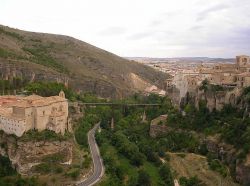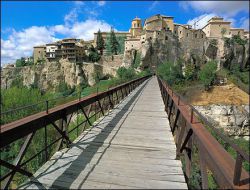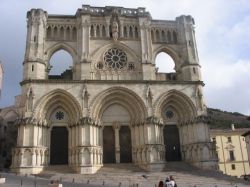Common description
Cuenca, located on a rocky ledge between the Hukar and Uekar Rivers, is only Toledo inferior in beauty and beauty to all Castilian cities. The old part of the city with impressive "hanging" over the cliff houses is relatively small and centered around the Romanesque-Gothic cathedral, located near the square. Major. At the foot of the old city, in the new southern quarters are railway and bus stations. Half a day is enough to get to know Cuenca.
Cuenca became famous in the XI century. After the Moors erected a fortified town on a cliff, on the site of a Roman settlement. In 1177 Christians led by Alfonso VIII expelled the Moors, but the inhabitants of Cuenca retained the main occupation of their classes - the trade in fabrics, wool and carpet. It was through the trade of the city of the rich that temples and mansions were built here.
Start your walk along Cuenca from Sq. Manganese, in the center of which stands the Manganese Watchtower - the only one preserved from the Arab fortifications. At the top of the tower is now a viewing platform. Along the west facade of the museum stretches the medieval Santa Maria Street, at the end of which is the Baroque City Hall (XVIII) and Sq. Major. To the west of the square, above the deep gorge at the bottom of which flows the Uekar River, stands the Gothic church of San Miguel with arches in the Arabian style. And the entire eastern part of Sq. Major occupies the cathedral. Construction of the temple on the site of the mosque began in the XII century. And ended in the XVI century. The temple has a beautiful carved altar; you can visit the sacristy of the cathedral and a small museum where paintings of El Greco are on display.
Running around the cathedral on the street. Obispo-Valero, you will find yourself above a rocky cliff, on the very edge of which are built the famous Casas kolgadas - "hanging houses" of the XIV century. with wooden balconies. There are now open restaurants, and one of the buildings is occupied by the Museum of Abstract Art. Building No. 12 houses the Cuenca History Museum.
Next to the village of Ukles on the hillside stands a medieval monastery fortress, often called the Lamanchi Escorial, for its inaccessible appearance. In the XII century. it was built by the Knights of the Order of Santiago near the border with the Arab states. Behind the mighty monastery walls is the Renaissance building that now houses the seminary.
Cuenca became famous in the XI century. After the Moors erected a fortified town on a cliff, on the site of a Roman settlement. In 1177 Christians led by Alfonso VIII expelled the Moors, but the inhabitants of Cuenca retained the main occupation of their classes - the trade in fabrics, wool and carpet. It was through the trade of the city of the rich that temples and mansions were built here.
Start your walk along Cuenca from Sq. Manganese, in the center of which stands the Manganese Watchtower - the only one preserved from the Arab fortifications. At the top of the tower is now a viewing platform. Along the west facade of the museum stretches the medieval Santa Maria Street, at the end of which is the Baroque City Hall (XVIII) and Sq. Major. To the west of the square, above the deep gorge at the bottom of which flows the Uekar River, stands the Gothic church of San Miguel with arches in the Arabian style. And the entire eastern part of Sq. Major occupies the cathedral. Construction of the temple on the site of the mosque began in the XII century. And ended in the XVI century. The temple has a beautiful carved altar; you can visit the sacristy of the cathedral and a small museum where paintings of El Greco are on display.
Running around the cathedral on the street. Obispo-Valero, you will find yourself above a rocky cliff, on the very edge of which are built the famous Casas kolgadas - "hanging houses" of the XIV century. with wooden balconies. There are now open restaurants, and one of the buildings is occupied by the Museum of Abstract Art. Building No. 12 houses the Cuenca History Museum.
Next to the village of Ukles on the hillside stands a medieval monastery fortress, often called the Lamanchi Escorial, for its inaccessible appearance. In the XII century. it was built by the Knights of the Order of Santiago near the border with the Arab states. Behind the mighty monastery walls is the Renaissance building that now houses the seminary.
Cuenca on map
+ 16°C





